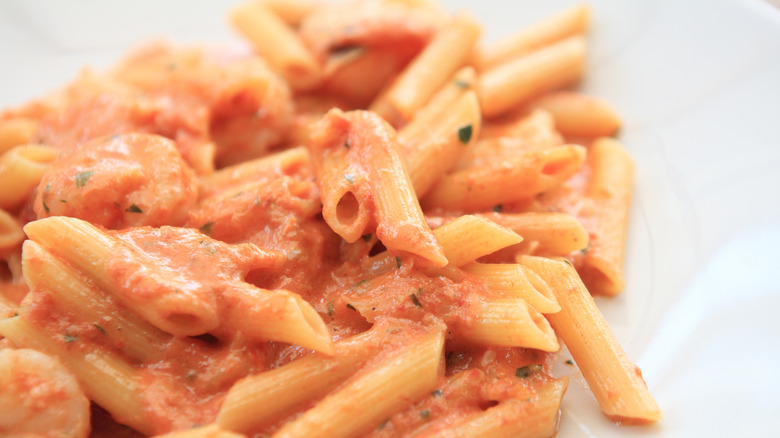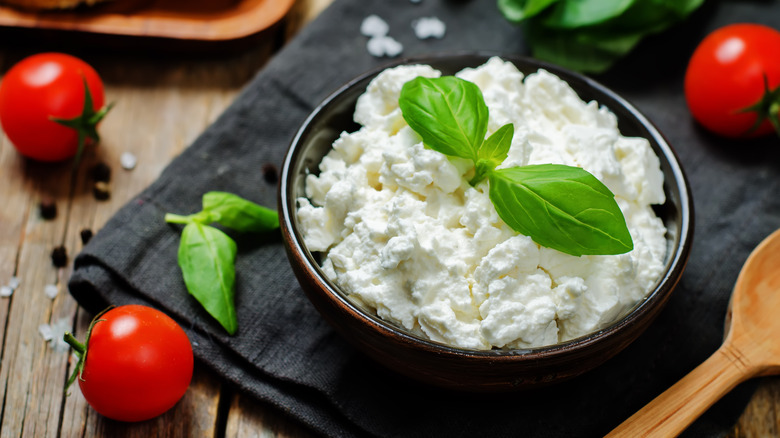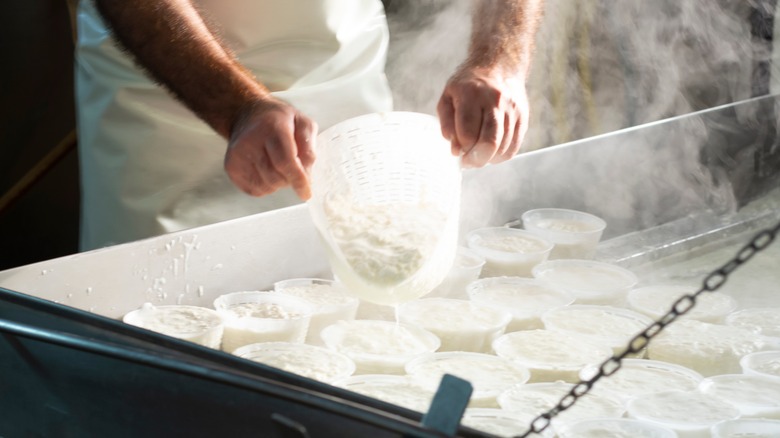Totally Elevate Store-Bought Tomato Sauce With A Scoop Of Ricotta
Peanut butter and jelly are great together, sure. But they're far from the only culinary power pairing. What would popcorn be without butter? Why bother with a burger without the fries, or chips without the salsa? When it comes to pasta, it's almost impossible to conjure an image of spaghetti piled high without a shower of parmigiano or other grated cheese.
But that's far from the only dairy that can lay claim to tomato's heart. Ricotta, with its delicate texture and lightly sweet, grassy flavor, is a beautiful partner for your favorite summer red fruit. And the easiest way to enjoy this perfect pairing anytime of year, is to simply grab your go-to tomato sauce from the grocer's shelf, and stir in a dollop of the cheese.
The beauty of this ricotta-sauce combo is how many ways you can enjoy these ingredients together. Simply dressing your favorite pasta is an easy anytime meal, but you'll find plenty of options for experimenting. Use it as a pizza sauce or to elevate your risotto. Slather between slices of bread with basil leaves for a spin on grilled cheese, or smear on eggs for a sweet and savory start to the day. It's an all-in-one ingredient for layering into classic lasagna or stuffing pasta shells, but is delicious enough all on its own to simply serve on toast.
Why this pairing works
This combination works because of its simplicity, and also the natural science at play, particularly when it comes to balancing flavors. Tomato sauce is a fairly acidic ingredient (clocking in around 4.5 on the pH scale; for a frame of reference, something like a pumpkin, which has a lot of natural sweetness, is typically around 5 to 5.5. On the pH scale, foods that are higher in acidity have lower numbers.) Ricotta's pH can vary depending on a number of factors, but is often closer to 6. So, by mixing these two ingredients together, you're tempering the level of acidity and creating a more balanced flavor profile. This gives you an opportunity to add a little ricotta as you go, tasting until you reach the level of tang that works for you. The combination of umami from the tomatoes and the slight sweetness of the cheese (often used in desserts like cannoli), is a study in complementary taste.
Additionally, because ricotta is such a light and airy cheese, rather than a dense grated one, mixing it into your tomato sauce gives it a little lift, bringing an ethereal creaminess to the whole affair. A fun bonus? It happens to be pretty, too; the two ingredients combined create an appealing pink-ish hue (common of other creamy tomato sauces, like penne alla vodka). There's also a practical benefit when it comes to plating: The cheese helps the sauce stick to your pasta.
Ricotta brings more to sauce than just flavor and texture
Ricotta is a light and creamy whey cheese, which means it's made from the liquid left behind after making an initial cheese making process (during which the curds are separated from the whey). The word "ricotta" translates in Italian to "recooked" which refers to the fact that this whey, along with any leftover curd bits, is then cooked again with a little added milk and acid (either from citrus or vinegar). Afterward, it's strained and packaged, but it manages to retain lots of moisture as opposed to something like an aged Parmigiano Reggiano or Pecorino Romano. This moistness helps to keep your sauce luscious.
Ricotta also happens to have lots of nutritional benefits. It's a great source of protein and calcium. Its low glycemic index is helpful for blood sugar management, and it's rich in Vitamins A and B12, as well as zinc and magnesium. Of the many ways you can elevate your store bought tomato sauce, adding ricotta is an easy, always delicious option that brings a whole lot to the table.


